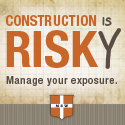BY JOSHUA ESTRIN, SENIOR ASSOCIATE
STEPHEN A. ESTRIN & CO. INC.
The average safety hard hat weighs approximately 14 ounces. The average worker’s head weighs 14 pounds. So there is an ounce of safety for every pound of head — provided the head protection is properly worn and maintained. But there is more to safety than the equipment protecting the noggin. And hard hat talks, regularly scheduled construction safety meetings, should extend beyond the topic of actual hard hats; content must reflect not only the culture and climate of safety on the jobsite, but utilize effective and efficient means to educate workers. In addition, they should support engagement as some of the most powerful lessons in worker safety come from the worker, as a result of topics or questions posed by the supervisor.
The construction industry has recently begun to recognize that safety cannot be an afterthought, but instead needs to be a priority that drives all decisions from the top down and bottom up. A safe work environment free of seen and unseen hazards must be non-negotiable and as such, should be something that is understood as the single most important way in which to proactively avoid accidents and ensure worker safety.
To that end, how do those charged with creating a strong culture and climate of safety evolve past the outdated models that often include a short video, a scripted generic monologue leaving no room for discussion, or — worst case scenario — a handout with little or no explanation or consideration for worker literacy levels and potential language barriers?
Safety does not happen in a vacuum and as such, just like other aspects across the continuum of a construction worksite, hard hat talks, once seen as informal safety meetings, must now be recognized as powerful tools and part of the entire safety plan with the singular focus to keep workers safe.
WHO SHOULD CONDUCT A HARD HAT TALK?
It’s imperative that the person spearheading these meetings has direct supervision over the worker. In the ever-evolving process and day-to-day adjustments of keeping the worker safe, choosing to bring a safety manager to a hard hat talk might seem like a good idea, but in fact can lead to unnecessary confusion as to who is directly charged with the day-to-day safety of the worker, that of the supervisor.
WHAT MAKES A HARD HAT TALK EFFECTIVE?
Generic topics do not work, as safety is not generic and must be site- and task-specific. Therefore, a supervisor must take the necessary time to ensure that discussions are not only specific, but highly relevant to the workers for whom he or she is responsible.
Recognizing that not all supervisors are comfortable speaking publicly, even if it is to workers with whom they interact every day is simply not an excuse for poorly executed hard hat talks. When one assumes the role and responsibility of ensuring the safety of others, he or she must also take responsibility for the entirety of that job description and work to overcome any personal challenges that impede effectively communicating worker safety.
The effectiveness of these meetings is determined by:
- How topical to the subject matter is to the tasks expected of the worker,
- How relevant the topic is to the job at hand, and
- How accessible the presentation is and how easy is it for workers to understand the entire discussion.
FREQUENCY
Another area of consideration is the frequency of hard hat talks. As with all aspects of safety and in turn creating a strong culture and climate of safety, these discussions cannot be applied haphazardly and should also reflect the level of hazard associated with a specific jobsite and the specific tasks being asked of the worker.
Collectively, if the industry is to make it a priority, weekly hard hat talks are simply not enough. Historically, it has been argued that this gives the supervisor time to assemble a crew based on varying schedules as well as prepare for an effective discussion. Given the data generated from the Bureau of Labor Statistics, this approach has not worked as was once hoped. Construction workers continue to suffer catastrophic as well as fatal injuries far above the national average and therefore greater regularity will in turn reinforce an overall commitment to ensuring a safe work environment.
DURATION
Traditionally approached as informal in nature, the movement toward a more formalized process appears to be a large part of the solution to keeping the construction workforce safe, but formality should not be confused with the need for a long drawn out discussion which is counter productive. Hard hat talks are most effective when they are focused and well planned. Ironically, it is in fact the shorter format that usually requires the most preparation as the supervisor must be ready and extremely well-versed on the topics to be discussed. Cutting through unnecessary information that may be interesting (but not relevant) and narrowing the talk down to essential information while presenting an engaging and supportive discussion takes time, creativity and a willingness to no longer settle for the status quo.
Worker safety is an enormous responsibility and although part of a large and complex system comprised of policies, procedures, regulations and industry standards, the process of imparting important safety-related information and knowledge to workers need not be overwhelming to the supervisor. The potential effectiveness for well-constructed hard hat talks is quite promising and as such, the industry must rise above what has been done in the past and meet the future with a sense of urgency and creativity driven by a genuine desire to keep the worker safe.
Joshua Estrin is a senior associate at Osprey, Florida-based construction forensic services firm Stephen A. Estrin & Co. Inc., an AGC of Greater Florida chapter, specializing in behavioral safety management. He is also an adjunct professor at Columbia University, in New York City. He can be reached at joshua@sa-estrin.com.

 2300 Wilson Boulevard, Suite 300 · Arlington, VA 22201 · 703-548-3118 (phone) · 703-548-3119 (fax) · www.agc.org
2300 Wilson Boulevard, Suite 300 · Arlington, VA 22201 · 703-548-3118 (phone) · 703-548-3119 (fax) · www.agc.org
 13 Steps to Improve Workplace Safety Amid Influx of New and Inexperienced Workers
13 Steps to Improve Workplace Safety Amid Influx of New and Inexperienced Workers



 Grab your hats, don your boots, and join your fellow construction industry professionals at the
Grab your hats, don your boots, and join your fellow construction industry professionals at the